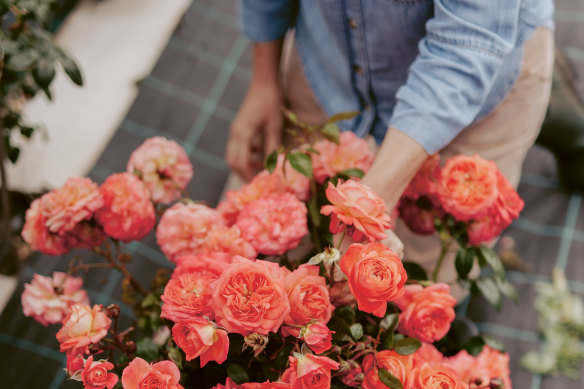
When it comes to growing the flowers, Starling and McCabe encourage an ecologically sensitive approach so that, even when the flower is cut and brought indoors, you can sense the hand of nature.
Loading
They suggest seeking local advice on the roses that will best suit your climate, which not only paves the way for more sturdy growth but also means your plants are less likely to be ravaged by pests and diseases. Not even the biggest, most ruffled and most romantic of blooms are worth months of sickly looking foliage.
Aphids, thrips, mites, and black spot are just some of the ills that can bedevil roses. To help keep them at bay, Starling and McCabe also encourage the use of companion plants.
“Good riddance to the traditional and drearily municipal ‘rose bed’ featuring nothing but roses emerging from a sea of mulch. Such a waste of space,” they write.
Flowering perennials, annuals, and bulbs woven around roses not only reduce the reliance on chemical intervention but also make for more lively looking beds.
This is true whether you grow in a cool or a warmer climate, including in Sydney, where roses can be challenging due to the humidity.

When it comes to cut roses, Starling and McCabe like a high petal count.Credit: Christopher Morrison
It’s worth taking note of the strategies put in place to ensure success at the 18-year-old Palace Rose Garden at the Sydney Botanic Gardens – the ninth at the institution, which is an indication of how tricky things can get there. These include the introduction of companions around the roses to attract beneficial insects and to generally increase biodiversity, the removal of hedges to improve airflow and the selection of modern cultivars that have been bred for disease resistance.
The importance of careful selection is also highlighted at Melbourne’s Royal Botanic Gardens, which houses a Climate Ready Rose Collection displaying those species and cultivars that may tolerate future climate change.
The idea is to inspire visitors to select roses based on their resilience rather than on how their flowers look. Alongside tough stalwarts, like Mutabilis and the vigorous climbing Crepescule, this collection features less common fare, such as Rosa sericea, omeiensis Astrosanguinea with theatrical red thorns and the even stranger Rosa x odorata Viridiflora, which sports green “flowers” or, strictly speaking, bracts.
The ideal time for planting is in winter when you can choose from a wide range of bare-rooted offerings, but it is possible to acquire potted specimens all year.
Choose a sunny spot with well-drained soil plied with compost. Keep your rose well-watered, at least until it gets established. Pruning will then be the biggest job, but other than that, just enjoy the show.
Secrets from the Flower Farm: Growing abundant flowers in unpredictable conditions (Thames & Hudson) by Christine McCabe and Rebecca Starling is out now.
Make the most of your health, relationships, fitness and nutrition with our Live Well newsletter. Get it in your inbox every Monday.









 Add Category
Add Category